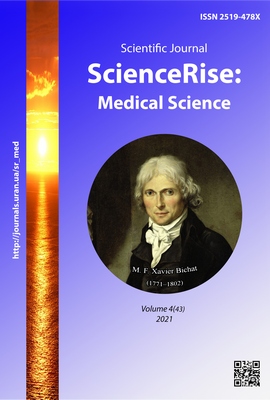Особливості клітинної, гуморальної ланок імунітету та динаміки імуноглобулінів при позалікарняній пневмонії у дорослих та їх значення для діагностики та прогнозу захворювання
DOI:
https://doi.org/10.15587/2519-4798.2021.237712Ключові слова:
позалікарняна пневмонія, патогенез, імунітет: клітинний та гуморальний, імуноглобуліни, цитокіни, запалення, діагностикаАнотація
Метою дослідження було вивчення особливостей імунного стану на основі аналізу клітинної і гуморальної ланок імунітету та динаміки імуноглобулінів у дорослих, що страждають на позалікарняну пневмонію (ПП), та їх значення в патогенезі та прогнозі захворювання.
Матеріали і методи. Дослідження проводилося в період 2017-2020 років на базі терапевтичного відділення Комунального некомерційного підприємства «Міська багатопрофільна лікарня № 25» Харківської міської ради. В дослідженні взяли участь 20 дорослих хворих, що страждали на ПП, віком від 18 до 80 років (середній вік 36,5±10,3 років). Контрольна група була сформована з 20 практично здорових пацієнтів (середній вік 39,5±12,5 років). Вивчення імунного статусу пацієнтів проводили шляхом визначення фагоцитарного індексу, вмісту лімфоцитів, CD3+, CD4+, CD8+, CD16+, CD20+ та рівня імуноглобулінів класів A, G, M в динаміці захворювання: на першу та 10-у добу після госпіталізації.
Результати. На першу добу госпіталізації спостерігався значний дисбаланс фагоцитозу, Т- і В-ланок імунітету. На 10-у добу лікування підвищувався фагоцитарний індекс, кількість CD3+, CD4+, CD8+, CD16+ та CD20+. Також відмічали підвищення Ig M, зниження Ig A та Ig G. Отже, стандартна терапія хворих, що страждають на ПП, призводить до її клініко-рентгенологічного вирішення, але не супроводжується нормалізацією показників імунітету.
Висновки. Виявлено особливості імунних порушень у хворих, які страждають на ПП: запалення легень посилює дисбаланс в клітинній ланці імунітету: знижується рівень CD3+ та CD4+, відсутня динаміка відносної кількості CD20+. У гуморальній ланці імунного статусу достовірних змін не відбувається. Для лікування хворих, що страждають на ПП, окрім стандартної фармакотерапії, необхідно включати препарати стимулюючі імунітет
Посилання
- Eshwara, V., Mukhopadhyay, C., Rello, J. (2020). Community-acquired bacterial pneumonia in adults: An update. Indian Journal of Medical Research, 151 (4), 287–302. doi: http://doi.org/10.4103/ijmr.ijmr_1678_19
- Lanks, C. W., Musani, A. I., Hsia, D. W. (2019). Community-acquired Pneumonia and Hospital-acquired Pneumonia. Medical Clinics of North America, 103 (3), 487–501. doi: http://doi.org/10.1016/j.mcna.2018.12.008
- Huang, Y., Liu, A., Liang, L., Jiang, J., Luo, H., Deng, W. et. al. (2018). Diagnostic value of blood parameters for community-acquired pneumonia. International Immunopharmacology, 64, 10–15. doi: http://doi.org/10.1016/j.intimp.2018.08.022
- Brands, X., Haak, B. W., Klarenbeek, A. M., Otto, N. A., Faber, D. R., Lutter, R. et. al. (2020). Concurrent Immune Suppression and Hyperinflammation in Patients With Community-Acquired Pneumonia. Frontiers in Immunology, 11. doi: http://doi.org/10.3389/fimmu.2020.00796
- Ketlinskiy, S. A. (1999). Sovremennye aspekty izucheniya tsitokinov. Russian Journal of Immunology, 4 (1), 36–52.
- Mancini, G., Carbonara, A. O., Heremans, J. F. (1965). Immunochemical quantitation of antigens by single radial immunodiffusion. Immunochemistry, 2 (3), 235–239. doi: http://doi.org/10.1016/0019-2791(65)90004-2
- Lapach, S. N., Chubenko, A. B., Babych, P. N. (2001). Statystycheskye metodы v medyko-byolohycheskykh yssledovanyiakh s yspolzovanyem Exel. Kyiv: Moryon, 408.
- Yu, Y., Fei, A. (2016). Atypical pathogen infection in community-acquired pneumonia. BioScience Trends, 10 (1), 7–13. doi: http://doi.org/10.5582/bst.2016.01021
- Kolek, V., Jakubec, P., Losse, S. (2017). Diagnostics and treatment of community-acquired pneumonia – simplicity is the key to success. Vnitrni Lekarstvi, 63 (11), 770–775. doi: http://doi.org/10.36290/vnl.2017.148
- Johnson, E. E., Wessling-Resnick, M. (2012). Iron metabolism and the innate immune response to infection. Microbes and Infection, 14 (3), 207–216. doi: http://doi.org/10.1016/j.micinf.2011.10.001
- Nair, G. B., Niederman, M. S. (2021). Updates on community acquired pneumonia management in the ICU. Pharmacology & Therapeutics, 217, 107663. doi: http://doi.org/10.1016/j.pharmthera.2020.107663
- Cherayil, B. J. (2010). Iron and Immunity: Immunological Consequences of Iron Deficiency and Overload. Archivum Immunologiae et Therapiae Experimentalis, 58 (6), 407–415. doi: http://doi.org/10.1007/s00005-010-0095-9
##submission.downloads##
Опубліковано
Як цитувати
Номер
Розділ
Ліцензія
Авторське право (c) 2021 Vladyslav Bereznyakov, Oleksiy Korzh, Sergiy Krasnokutskiy

Ця робота ліцензується відповідно до Creative Commons Attribution 4.0 International License.
Наше видання використовує положення про авторські права Creative Commons CC BY для журналів відкритого доступу.
Автори, які публікуються у цьому журналі, погоджуються з наступними умовами:
1. Автори залишають за собою право на авторство своєї роботи та передають журналу право першої публікації цієї роботи на умовах ліцензії Creative Commons CC BY, котра дозволяє іншим особам вільно розповсюджувати опубліковану роботу з обов'язковим посиланням на авторів оригінальної роботи та першу публікацію роботи у цьому журналі.
2. Автори мають право укладати самостійні додаткові угоди щодо неексклюзивного розповсюдження роботи у тому вигляді, в якому вона була опублікована цим журналом (наприклад, розміщувати роботу в електронному сховищі установи або публікувати у складі монографії), за умови збереження посилання на першу публікацію роботи у цьому журналі.










